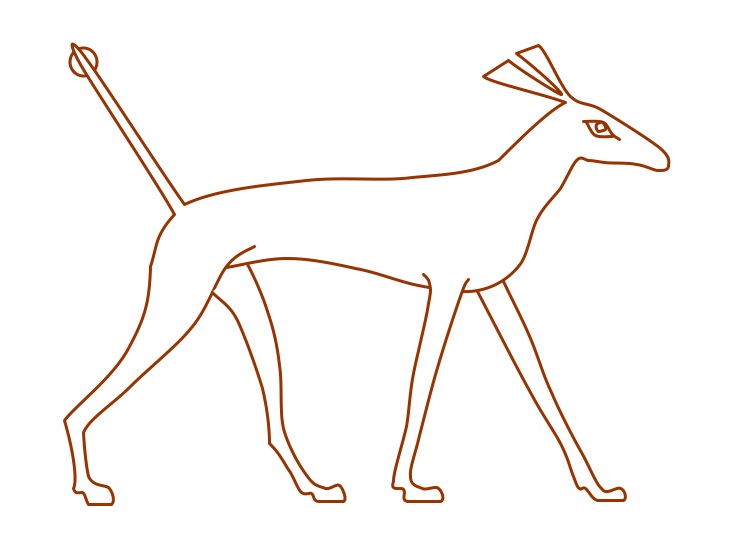Basic Information
Egyptian Mythology has a lot of animal-headed deities. Anubis had the head of a jackal, Bastet the head of a Cat, Horus and Ra had Hawk-heads, Sobek had the head of a Crocodile, and so forth.
The sinister God Set had the head of a… a… what is that thing?
a… what is that thing?  It's a… It's a Set Animal, that's what it is all right.
It's a… It's a Set Animal, that's what it is all right.
A Set Beast seems to be kind of like a canine, but the snout arcs downward, maybe a little like an anteater. It has tall ears that have really square tops, and taper down like a triangle to the point where they attach to the skull.


It's not just Set's head, either. There are plenty of ancient depictions of the creature's entire body. Again, kind of dog- or jackal-like, but with a really specific build, long-legged and lean like a greyhound. And it has a tail that's always shown standing straight up, with a tip that's either forked or has some sort of a tuft at the end. There's no existing species that it's clearly depicting, but the hieroglyphs and illustrations are always real specific on the details. Details that, other than a little variation in the last 15% of the tail, remained pretty consistent across 2,000 years of artwork. Its coloration is either black, red, or a combination.
Scholars are divided on whether or not the Set animal was a real species that's long since gone extinct, a mythical composite monster, or just an artistic or religious tradition that artists felt compelled to be faithful to in their artwork. It may be an extinct breed of dog (or African wild dog), or even a stylized aardvark.
The Set animal is also sometimes known as the Sha. Via the wonders of Interpretatio Graeca the Greeks conflated Set with Typhon. That means that another acceptable name for the Set animal is the Typhonian Animal or Typhonian Beast.
When it appears in heiroglyphs, aside from denoting the literal presence of Set, it is often a signifier of chaos, violence, storms, or disasters.
The set animal was also the basis for the shape of the Was-sceptre, a rod or staff carried by some deities and later some pharoahs. The was-sceptre has a hook and protrusion at one end that sort of suggest the head of the set animal. At the bottom, it ends in a curved two-pronged fork that matches one of the most common ways the set animal's tail was depicted. Tradition held that the was-sceptre gave the bearer dominion over the forces of primal chaos. (The picture of Set on the above left has him holding a was-sceptre in one hand and an anhk in the other.)
Sources
Illustration Credits:
Game and Story Use
- Let's be realistic here. Arcanawiki is primarily a gaming site. So you're almost certain going to want it to be some sort of cryptid or mythological creature with cool powers. See "Building This Character" for ideas.
- Set may have a pack of feral hunting Beasts, or the Set Animals may be intelligent free-roaming agents. Official details are very sparse, so as GM (or author) you get to fill in the gaps however you want.
- An interesting magic item concept might be a was-sceptre that can be commanded to transform into a set animal, or vise-versa.
- It might also be able to channel, unleash, or hold-at-bay chaos energy. The bident fork at the bottom might be a powerful destructive weapon.
Building This Character
- That peculiar curved snout gives it some sort of special power,
- Perhaps it can burrow rapidly through the earth,
- It may have a ferocious bite or piercing attack where it slams its head down on the target like a pickaxe,
- Maybe the strange shape is to help it get the sent of its prey. It may be an excellent tracker.
- Or it's like an ant-eater, with a weird curved snout that holds a really long sticky tongue.
- The forked tail adornment seems important.
- If it's as spiky as it seems, it may give it another attack.
- Could be forked tails do different damage from flanged mace tails, if you feel like making variants.
- The tail itself may have magical properties, such as unleashing chaotic energies. That could explain why magic staves (i.e.: was-sceptres) of ancient Egypt mimicked the shape.
- Or it may be used to communicate. Perhaps it's a pointer, and the tail straight up mean it's on the hunt.
- If it's as spiky as it seems, it may give it another attack.
- The ears seem always alert, so it's pretty hard to sneak up on it.
- It may have some other more specific hearing-related power, if your game has anything of the sort.
- I suppose those could be some sort of bony ossicones or horns, not ears.
- As a creature of the villainous Set, it's no doubt a fierce combatant.
- Other animals sacred to Set include the scorpion, crocodile, wild boar and hippopotamus. The eponymous beast has to be at least on par with it's master's other favored pets.

